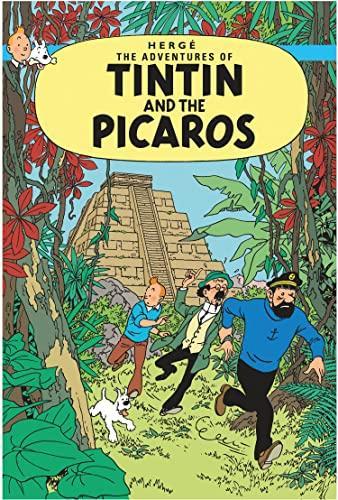Paperback, 62 pages
English language
Published March 8, 1978 by Methuen.

Paperback, 62 pages
English language
Published March 8, 1978 by Methuen.
Tintin and the Picaros (French: Tintin et les Picaros) is the twenty-third volume of The Adventures of Tintin, the comics series by Belgian cartoonist Hergé. The final instalment in the series to be completed by Hergé, it was serialized in Tintin magazine from September 1975 to April 1976 before being published in a collected volume by Casterman in 1976. The narrative follows the young reporter Tintin, his dog Snowy and his friends Captain Haddock and Professor Calculus as they travel to the (fictional) South American nation of San Theodoros to rescue their friend Bianca Castafiore, who has been imprisoned by the government of General Tapioca. Once there, they become involved in the anti-government revolutionary activities of Tintin's old friend General Alcazar. Hergé began work on Tintin and the Picaros eight years after completing the previous volume in the series, Flight 714 to Sydney, creating it with the aid of his …
Tintin and the Picaros (French: Tintin et les Picaros) is the twenty-third volume of The Adventures of Tintin, the comics series by Belgian cartoonist Hergé. The final instalment in the series to be completed by Hergé, it was serialized in Tintin magazine from September 1975 to April 1976 before being published in a collected volume by Casterman in 1976. The narrative follows the young reporter Tintin, his dog Snowy and his friends Captain Haddock and Professor Calculus as they travel to the (fictional) South American nation of San Theodoros to rescue their friend Bianca Castafiore, who has been imprisoned by the government of General Tapioca. Once there, they become involved in the anti-government revolutionary activities of Tintin's old friend General Alcazar. Hergé began work on Tintin and the Picaros eight years after completing the previous volume in the series, Flight 714 to Sydney, creating it with the aid of his team of artists at Studios Hergé. The setting and plot was inspired by Hergé's interest in Latin American revolutionaries, particularly those active in the Cuban Revolution. The book reflected changes to the appearance and behaviour of several key characters in the series; influenced by his design in the animated films Tintin and the Temple of the Sun and Tintin and the Lake of Sharks, Tintin is depicted wearing bell-bottoms instead of his trademark plus fours. The volume was published to a poor reception and has continued to receive negative reviews from later commentators on Hergé's work. Early criticism of the story focused on what was seen as its pessimistic portrayal of its political themes, while later reviews concentrated on the poor characterisation and lack of energy. Hergé continued The Adventures of Tintin with Tintin and Alph-Art, a story that he never completed, and the series as a whole became a defining part of the Franco-Belgian comics tradition. The story was adapted for an episode of the 1991 animated series The Adventures of Tintin by Ellipse and Nelvana.